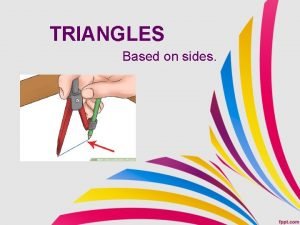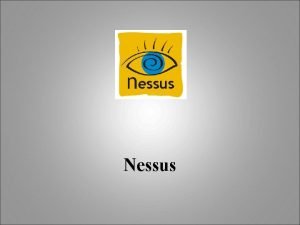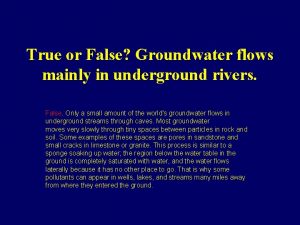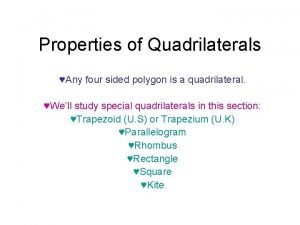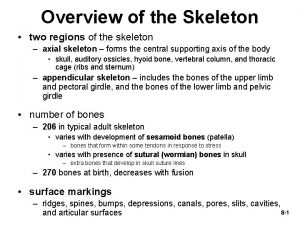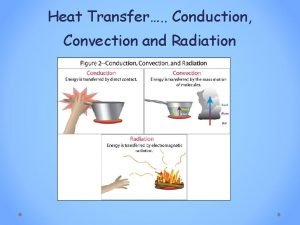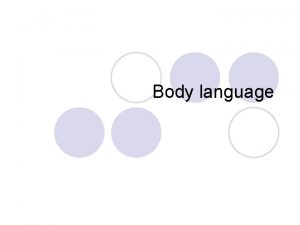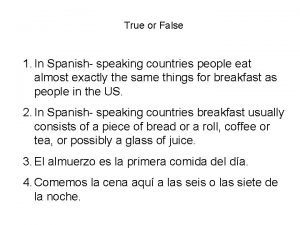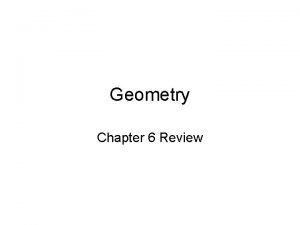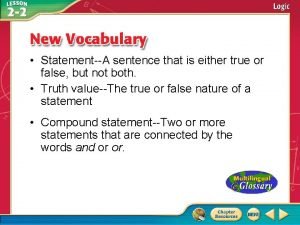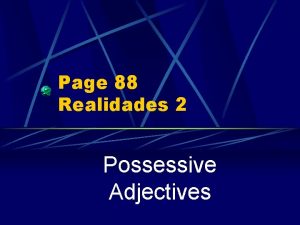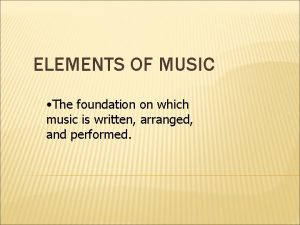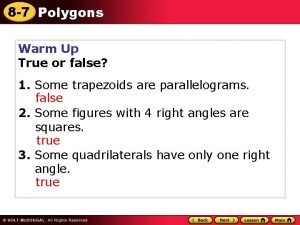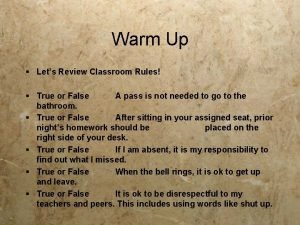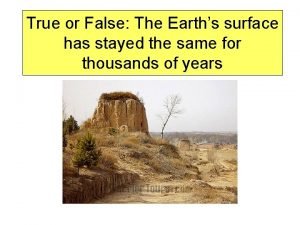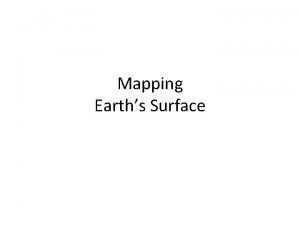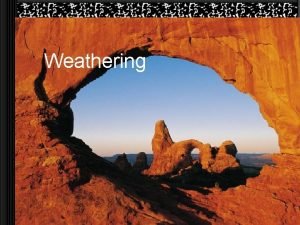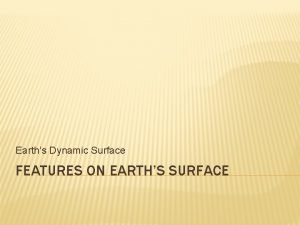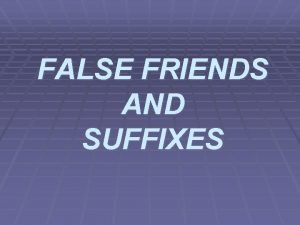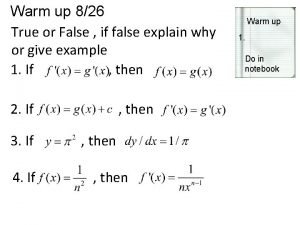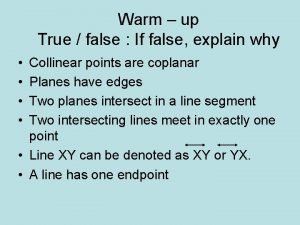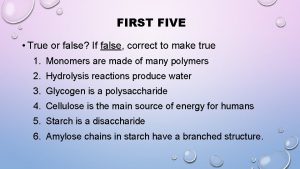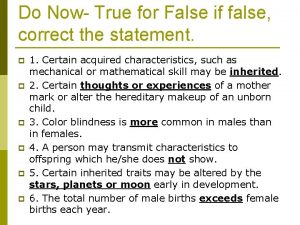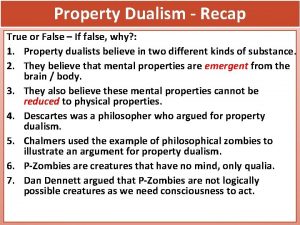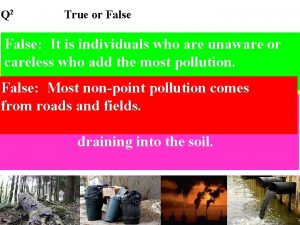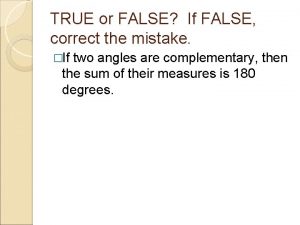True or False The Earths surface has stayed































































- Slides: 63

True or False: The Earth’s surface has stayed the same for thousands of years

True or False: The Earth’s surface has stayed the same for thousands of years The Earth’s surface is always changing!






Weathering The breakdown do the materials of Earth’s crust into smaller pieces.

Water causes weathering What evidence of weathering do you see in this picture?

Wind causes weathering Why wasn’t this mass of land weathered away? What evidence of weathering do you see in this picture?

Ice causes weathering Describe how ice causes weathering?

Erosion The process by which water, ice, wind or gravity moves fragments of rock and soil. What evidence of erosion do you see in this picture?

Erosion is Movement of Sediment! • This process, known as Erosion, is gradually wearing down the surface of the earth. • Erosion is the process by which weathered rock and soil (sediment) are moved from one place to another. • Erosion carves the Earth's surface creating canyons, gorges, and even beaches. What do you think has caused this rock to look this way?

Wind Erosion • As the wind blows it picks up small particles of sand/sediment and blasts large rocks with the abrasive particles, cutting and shaping the rock. • The intensity of wind erosion is determined by: • Sum (amount) • Speed • Slope • Surface Abrasion: the sediment or sand blows into rock and causes pits in the rocks. (Not a mass movement)

Wind Erosion • Abrasion: the sediment or sand blows into rock and causes scratches and pits in the rocks. (Not a mass movement)

Wind Erosion • Wind erosion cause deflation. Deflation: erosion of land by wind; can lower the lands surface

Wind Erosion • You can determine the wind direction. • You can also determine which direction the sand, or soil is migrating to.

Wind Erosion

Water Causes Erosion • runoff, rivers and, streams

Water causes Erosion When rain falls to the Earth it can evaporate, sink into the ground, or flow over the land as Runoff. When it flows over land, erosion occurs. Runoff picks up pieces of rock and "runs" downhill cutting tiny grooves (called rills) into the land.

Water causes Erosion Sheet Flow: When water moves downhill in thin sheets.

Water causes Erosion Rills: small channels cut in sediment If these channels get. 5 meters across they are now…. Gullies: larger channels at least. 5 meters across.

Water causes Erosion Gullies often lead into a stream.

Water causes Erosion How much erosion takes place is determined by the: • Sum (amount) • Slope • Speed • Surface Can you increase or decrease the 4 S's

Ice Causes Erosion Glaciers occur when snow accumulates faster than it can melt, and a massive body of snow packs down and becomes thicker and thicker, heavier and heavier, until it has the weight and mass of rock, even though it is still frozen water. How do glaciers form? Gravity then pulls this massive snow pack down to lower elevations, and as it travels, it shapes and scrapes, and fractures, and changes the surface of the earth.

How do glaciers form?

Continental vs. Valley Glaciers Continental Glaciers: Cover a whole continent; Arctic, Antarctic, Greenland, Valley glaciers: located in high mountains and are smaller glaciers running down between mountains.

Ice Causes Erosion Glaciers wear down the landscape; by picking up and carrying debris that moves across the land along with the ice.

Ice Causes Erosion Glaciers can pick up and carry sediment that ranges in size from sand grains to boulders bigger than houses. Moving like a conveyor belt and a bulldozer, a single glacier can move millions of tons of material!

Ice Causes Erosion Glaciers form a U-Shaped Valley.

Ice Causes Erosion How much erosion takes place is determined by the: • **Sum (Glaciers are massive!) • Slope • Speed • Surface

Ice Causes Erosion Till: sediment deposition What is left behind from melted glaciers; can when glaciers range from clay to melt? boulders. We will discuss this more when we discuss deposition.

Gravity causes erosion Creep, Slump, Landslides, Mudslides, and Avalanches. Slower Faster These are examples of mass movement landslide clip. mpeg (or called mass wasting)

Gravity causes erosion • Creep: Due to freezing and thawing; slow moving mass movement down a slope. Page 325 in book

Gravity causes erosion Example of Creep

Gravity causes erosion • slump: a mass of rock or sediment moves down hill leaving a curved scar. Page 324

Gravity causes erosion • rock slides: layers of rock break off and move to the bottom of a slope. Page 324

Gravity causes erosion • mud flow: a mass of wet sediment that flows downhill. Page 324

Gravity causes Erosion How much erosion takes place is determined by the: • Sum • **Slope • Speed • **Surface

Effects of Erosion • Sediment removed: forms canyons, valleys and mountain cirques A cirque ("serk") is a bowl-shaped rock valley on the side of a mountain, often with a glacier or permanent snowfield in it. (more below)

Effects of Erosion • Sediment deposition: forms deltas, sandbars, and sand dunes

Effects of Erosion • Sediment deposition: forms deltas, sandbars, and sand dunes

Plants CAN CAUSE weathering

Plants CAN PREVENT erosion

Deposition

Definition • Deposition- the process in which sediment is laid down in new locations – The end result of erosion

Deposition Rock particles that are picked up and transported during erosion will ultimately be deposited somewhere else Deposition is the process by which sediments (small particles of rock) are laid down in new locations. • Together, Erosion and Deposition build new landforms. • Deltas • Canyons • Meanders • Floodplains

Water Deposition • Alluvial fan- fan shaped deposit of sediment on land – Usually form when a stream slows down and enters a flat plain • Delta- sediment from a stream deposited where a river enters a large body of water – Triangular shape • Sand Bar- Sand dropped when the tide comes in.

Alluvial fan and Delta

Delta Where rivers meet the ocean is called the mouth of the river. Soil and dirt carried by these rivers is deposited at the mouth, and new land is formed. The new, soil-rich land is known as a Delta

Canyons This simple animation provides you with a visualization of how the Colorado River has "downcut" into the rock layers of the Grand Canyons are large valleys created by a river or stream. How long it took to carve the Grand Canyon is debated by geologists. Some estimates are between 6 and 8 million years, which is very recent by comparison.

Meanders Meandering streams wander side to side as they constantly seek out the lowest elevation. This constant motion creates a series of S-shaped “loops”.

Meanders Stream Velocity varies from one side to the other side of the “S”, resulting in erosion in some places and deposition of sediments in others.

Floodplains • Floodplains form along the banks of mid-order streams and larger rivers. • These are low-lying areas along the sides of a river channel that have regular times of heavy waterflow to cause the river to spill over and flood the land.

Glacial Deposition • As a glacier melts, it creates landforms by depositing its sediment load – Till-unsorted mixture of sediment containing fragments of various sizes – Moraine-mounds of sediment at the downhill end of the glacier and along its side • Long Island is a glacial moraine

Till and Moraines

Ice Causes Erosion Till: sediment deposition What is left behind from melted glaciers; can when glaciers range from clay to melt? boulders.

Ice Causes Erosion • Moraines: landforms made from deposition of till. • Terminal moraine: The farthest the glacier went; can be a ridge 30 m. tall and 10 km wide; The Southern most part of the glacier began to melt quicker than the ice formed.

Ice Causes Erosion • Ground Moraine: The till didn't build up a ridge because the glacier moving again. It still dropped some sediment off.


Ice Causes Erosion outwash: sand When melting gravel deposits laid down occurs, streams carry and deposit by these melted glacier streams. sediment.

Wind Deposition • Sand dunes- large deposits of sand dropped from wind – Sand dunes can move as the wind picks up sand from the back of the dune and blows it to the front

Wind Deposition • Other important vocabulary associated with wind erosion • Loess: (LOOS)- accumulation of silt or fine sediment. • Loess was created by deposits of sediment and dust from glaciers. • Loess- extremely fertile. • Topsoils made up of loess are found in the central and northwestern parts of United States, in central and eastern Europe, and in eastern China.
 Amer rasheed
Amer rasheed True or false
True or false Triangles based on sides
Triangles based on sides Meiosis has 8 main phases true or false
Meiosis has 8 main phases true or false Flat file isac
Flat file isac Expressing cause and result
Expressing cause and result Observation of rizal in london
Observation of rizal in london Where did they go last weekend
Where did they go last weekend Slidetodoc
Slidetodoc Electromagnetic waves are transverse waves true or false
Electromagnetic waves are transverse waves true or false Most groundwater comes from rain true or false
Most groundwater comes from rain true or false Are these statement true or false
Are these statement true or false False and true vocal cords
False and true vocal cords There are four season all over the world true or false
There are four season all over the world true or false All quadrilaterals are polygons true or false
All quadrilaterals are polygons true or false Find percentage increase
Find percentage increase Lumbat
Lumbat Take away any liquid near your working area true or false
Take away any liquid near your working area true or false True or false: mla requires a title page.
True or false: mla requires a title page. Logical operators in boolean algebra
Logical operators in boolean algebra True or false questions about leadership
True or false questions about leadership Heat transfers
Heat transfers Identify each statement as either true or false
Identify each statement as either true or false Identify whether each statement is true or false
Identify whether each statement is true or false Chapter 41 telephone techniques critical thinking
Chapter 41 telephone techniques critical thinking Chapter 3 true false quiz accounting
Chapter 3 true false quiz accounting In business letter a salutation is generally followed by a
In business letter a salutation is generally followed by a Body language
Body language Accounting chapter 11 test
Accounting chapter 11 test Luckiest man in the world
Luckiest man in the world Grains are types of grasses. true false
Grains are types of grasses. true false Me encantan los espaguetis. son muy _____.
Me encantan los espaguetis. son muy _____. Tipe data pascal untuk karakter
Tipe data pascal untuk karakter Tipe data logika yang bernilai true dan false ialah
Tipe data logika yang bernilai true dan false ialah True or false science questions
True or false science questions Spider is an insect true or false
Spider is an insect true or false Classify each statement as true or false.
Classify each statement as true or false. True or false psychology questions
True or false psychology questions Dorset road safety
Dorset road safety Wanted: a just right government
Wanted: a just right government Is dance always done to music
Is dance always done to music True or false
True or false To kill a mockingbird jeopardy
To kill a mockingbird jeopardy A sentence that is either true or false
A sentence that is either true or false Was i sexually harassed quiz
Was i sexually harassed quiz Eating food physical or chemical change
Eating food physical or chemical change Capitulo 2a possessive adjectives p.88
Capitulo 2a possessive adjectives p.88 Examples of minerals
Examples of minerals True or false
True or false What are the elements in music
What are the elements in music Choose the correct item give reasons
Choose the correct item give reasons Chapter 37 vital signs and measurements true or false
Chapter 37 vital signs and measurements true or false Chapter 8 telephone techniques
Chapter 8 telephone techniques The cell is the basic unit of life true or false
The cell is the basic unit of life true or false 5 classify the following sentences as true t or false f
5 classify the following sentences as true t or false f 7 angle shape
7 angle shape Theocracy can coexist with democracy true or false
Theocracy can coexist with democracy true or false The rules of the classroom true or false
The rules of the classroom true or false A method to make regular saving easier is ____.
A method to make regular saving easier is ____. Muticharts
Muticharts The open window by saki
The open window by saki True or false questions on research methodology
True or false questions on research methodology Rates of reaction can be positive or negative. true false
Rates of reaction can be positive or negative. true false True-false physical activity clues answers
True-false physical activity clues answers


